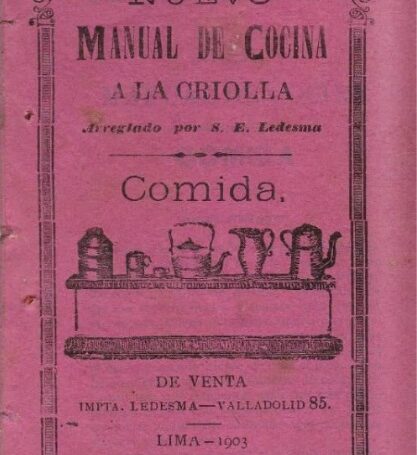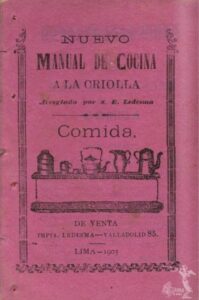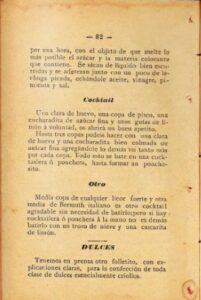
The Pisco Sour: Blending Cultures for a National Identity
In 2013, my mother fulfilled a lifelong dream to see Machu Picchu with a seven day trip to Peru.[1] While the ruins left an impression, the Peruvain hospitality accompanied with the ever-present Pisco Sour was also notable. She explained, “everywhere I turned, they were handing me a Pisco Sour!”
Perhaps this is to be expected on a packaged group tour because, after all, the Pisco Sour considered Peru’s national cocktail. However, the notoriety for this cocktail among Peruvian travelers is not at all surprising given its frequent cameos in literature since the 1930s. The 1936 travel book Westward from Rio references the cocktail during their stay in Peru with “In our hotel again, we asked for a pisco sour. . .” In the 1938 holiday travel issue of Vogue, a Peruvian visit includes the following passage, “Every one also gets very drunk on the equally famous Peruvian pisco, which, taken alone, is a foul and fiery potion, but, mised in a Pisco Sour at the Bolivar Hotel or at Lima’s attractive Country Club, is quite palatable.” Even today, the Pisco Sour is a main character in tales of South American adventure. During 2012 trip to Peru Andy Isaacson of the New York Times explains, “No Peruvian cocktail is more classic than the pisco sour.”
Pisco is a spirit distilled from a young wine of specific grapes. It is similar to its European cousins, grappa or brandy. However, Pisco is a unique, young distillate distilled once from a young wine and it is neither rectified with water nor aged after distillation.[5] It is often referred to as a brandy in references and literature, but, unlike brandy, it is clear and not aged in barrels. Given its youth, it retains some of the aromatic characteristics of the grape variety used. While there are many varieties of Pisco, the two prominent grape varietials used for production are Quebranta and Negra Criolla. Each is reported to exhibit its own character. Quebranta is fruity and results in a higher alcohol. Negra Criolla is considered ‘well-structured’ and green.
Pisco in Peru and Chile originated with the 16th century Viceroyality of Peru, a Spanish colony. Distillation of wine from the European grapes brought by the Spanish began sometime in the 17th century. It is believed this transition was in response to efforts by the Spanish crown to quell colonial wine imports to Spain.[9] Realizing the booming wine industry in the colonies had negative economic impacts at home, the Spanish crown employed several tactics including bans on planting vines in the colonies, bans on sale of Peruvian wines and ultimately, exorbitant taxation on Peruvian wines.[10] Despite these many efforts wine production in Peru continued on through brandy production.

The transition to distillation was also aided by a other factors. For example, mining towns in the high Andes spurred a demand to transport alcohol across rugged, high-altitude terrain. Given pack mules and llamas loaded with ceramic vessels were the primary means for transporting alcohol, economics suggest one would pack alcohol with the most punch. Another factor may have been the collapse of a ‘wine-boom’ in the early 17th century. With excess wine grapes after the boom, brandy may have been a means to preserve the crop longer. Historical and archaeological investigation suggests Peru produced as much as 7 million liters of wine for brandy during the late 18th century. In the 19th century, Peru’s signature brandy became known by pisco which is also the name of the valley where the grapes are grown and its nearby port.

Although the focus of this review is Peruvian Pisco and the Peruvian cocktail, the Pisco Sour, the current landscape of Peruvian Pisco is heavily defined by the dispute with Chile over national ownership of pisco during the late 19th and early 20th century. While Peru, Bolivia and Chile gained their independence from Spain decades earlier, their borders not were ultimately settled until after the War of the Pacific in 1884. Chile’s decisive victory over Peru and Chile won it new lands and coastlines. It also, ultimately, left Peru bitter over the conflict. This bitterness led to policies that isolated Peru from international trade while Chile continued to build international relations. As a result Peru’s pisco production has historically suffered where they only produced 231,190 liters compared to Chile’s 49 million liters in 2009. The dispute rages on with both countries claiming an appellation of origin for pisco.
Inside of Peru, pisco’s nationality is undisputed. It is the national drink of Peru and the Pisco Sour its national cocktail. This strong sense of nationality is so engrained that in 2003 Peru declared the First Saturday in February “Día Nacional del Pisco Sour” (translated: National Pisco Sour Day). It seems the fight is primarily portrayed by Peru because in 2007, the government even rejected an offer by Chile to join share pisco and economic forces. To this day, Peru maintains a strict customs ban on bringing any pisco into the country that is not of Peruvian origin.
How the Pisco got into Peru is easier to answer than the question of how the sour got into the Pisco Sour. According to popular lore, the Pisco Sour was invented by ex-patriot Victor Morris. While in Peru working for the railway, he opened Morris’ Bar in Lima. He is believed to have invented the drink as a substitute for a Whiskey Sour. One of the first literary accounts of drinking a Pisco Sour appears in General Dean Ivan Lamb’s memoir Incurable Filibuster. During his travels in Peru in 1922, he described the cocktail as a “pleasant soft drink.”
However, the anatomy of a Pisco Sour is different than that of a Whiskey Sour. A Pisco Sour is a cocktail using pisco, lime juice, sugar and egg whites. As described in Harry Johnson’s 1888 version of The New and Improved Illustrated Bartenders’ Manual, the Whiskey Sour uses sugar, lemon juice and whiskey. Charles Mahoney’s 1914 New Bartender’s Guide includes the addition of “1 Squirt of Syphon Selters water.” Aside from the liquor, the key difference between the two drinks is the addition of an egg white in the Pisco Sour. There are modern Whiskey Sour recipes found on the internet that include an egg white, but largely, they stay true to the 1888 and 1914 versions. On the other hand, Pisco Sour recipes seem to universally use an egg white.
It is certainly possible Victor Morris made his first Pisco Sour exactly as portrayed, substituting Pisco into the Whiskey Sour and not using egg white at all. It is also certainly possible that the drink evolved at Morris’ Bar to include the egg white at a later date. Perhaps, the frothiness produced by an agitated egg white was a reasonable substitute for “1 Squirt of Syphon Selters water.” Indeed, if this is the case, similar to other immigrant cultures who adapt their traditional recipes to the local ingredients of their host country, the Pisco Sour is a Peruvian drink created by an American.
It seems the history of the Pisco Sour is still being written as new artifacts are discovered. In late 2013, Franco Cabachik, a Latin American cocktail aficionado and blogger from Peru, posted an image of a cookbook dating back to 1903 (see Figure 1). The cookbook is titled Neuvo Manual de Cocina a la Criolla (translated: New Manual of Creole Cooking). A digital version of the cookbook is readily available to review. In this cookbook, the recipe for “Cocktail” appears just before the index (see Figure 2). The line “Una clara de huevo” translates to “One clear egg.” This “Cocktail” recipe includes all of the elements of a modern day Pisco Sour – egg white, pisco, sugar and lime juice.
Little is known about this cookbook and it does not appear to have been authenticated yet. The recipe in question itself has some peculiarities. The fact that the term “Cocktail” is used as a title for the recipe is a curiosity. The word “Cocktail” is originated in America in the early 19th century. It is the only recipe in the book that uses an American term. A look at the “Otro” drink recipes that follows “Cocktail” uses “Bermuth italiano es otro cocktail.” This “other cocktail,” as the name implies, is an Italian cocktail using Vermouth. If this cookbook proves authentic, perhaps cocktail culture was already being imported to Peru prior to Morris’ arrival.
Like pisco, the alcohol, it seems the Pisco Sour, the cocktail, also has disputed appellation. Evidence indicates it was invented in Peru, but it seems to have been influenced by immigrants.
Beginning with Spanish colonialism, a part Peru’s identity has been defined by the product of the European grapes transplanted there. The booms and busts of the wine economy led to the distillation of a brandy unique to Peru called pisco. Later, claiming pisco’s appellation as Peruvian became means of reliving geo-political battles and a focal point of national pride. Whether Peru’s dominion of Pisco and the Pisco Sour are ever internationally recognized, it is clear they both are linked to the identity of Peru.
_____________________________________________________________________
Bibliography
1. Bowman, Heather, and Stirling Dickinson. Westward from Rio. Michigan: Willett, Clark & Company, 1936.
2. Cacho, Juan, Liliana Moncayo, and Juan Carlos Palma. “The impact of grape variety on the aromatic chemical composition of non-aromatic Peruvian pisco.” Food Research International, no. 54 (2013): 373-381.
3. Diner, Hasia R. Hungering for America: Italian, Irish, and Jewish Foodways in the Age of Migration. Cambridge: Harvard University Press, 2009.
4. Gotkine, Elliott. BBC UK: Peru and Chile quarrel over brandy drink. December 16, 202. http://news.bbc.co.uk/2/hi/business/2573799.stm (accessed June 10, 2014).
5. Johnson, Harry. The New and Improved Illustrated Bartenders’ Manual; Or: How to Mix Drinks of the Present Style. New York: Harry Johnson, 1888.
6. Lamb, Colonel Dean Ivan. The Incurable Filibuster Adventures of Colonel Dean Ivan Lamb. New York: Farrar & Rinehart, 1934.
7. MacKinnon, Miranda. Peru This Week: The famous Peruvian Pisco Sour: An introduction. October 25, 2013. http://www.peruthisweek.com/food-the-famous-peruvian-pisco-sour-an-introduction-101206 (accessed June 10, 2014).
8. Mahoney, Charles S. New Bartender’s Guide: Telling how to Mix All the Standard and Popular Drinks. Balitmore: L & M Ottemheimer, 1914.
9. MITCHELL, JERRY T., and WILLIAM C. TERRY. “CONTESTING PISCO: CHILE, PERU, AND THE POLITICS OF TRADE.” The Geographical Review 101, no. 4 (October 2011): 518-535.
10. Nico. Pisco Trail: The Origins of the Psico Sour. Dec 9, 2013. http://www.piscotrail.com/2013/12/09/culinary-history/the-origin-of-the-pisco-sour/ (accessed June 10, 2014).
11. “Nuevo Manual de Cocina a la Criolla.” 1903. http://issuu.com/davidpino7/docs/recetario1903/31?e=2530478/2873904 (accessed June 2014, 10).
12. Oxfod University Press. Oxfod Dictionaries: Cocktail. 2014. http://www.oxforddictionaries.com/us/definition/american_english/cocktail (accessed June 14, 2014).
13. Peru Tourism Bureau (PTB). Visit Peru: Night life Food and Drinks. http://www.visitperu.com/travel-tips/night-life-food-and-drinks/ (accessed June 14, 2014).
14. Rice, Prudence M. “Peru’s colonial wine industry and its European background.” Antiquity 70 (December 1996): 785.
15. Rice, Prudence M. “Wine and brandy production in colonial Peru: a historical and archaeological investigation.” The Journal of Interdisciplinary History 27, no. 3 (1997): 455(25).
16. Vecchio, Rick. Beguiling History of the Pisco Sour, With a Twist. January 23, 2014. http://www.peruviantimes.com/23/beguiling-history-of-the-pisco-sour-with-a-twist/21309/ (accessed June 10, 2014).
17. Vogue. “Voyage to Valparaiso.” December 15, 1938: 96.
Leave a Reply